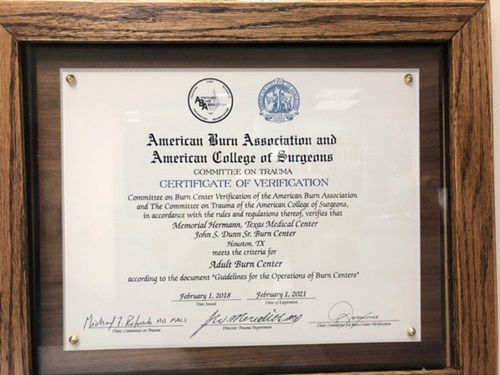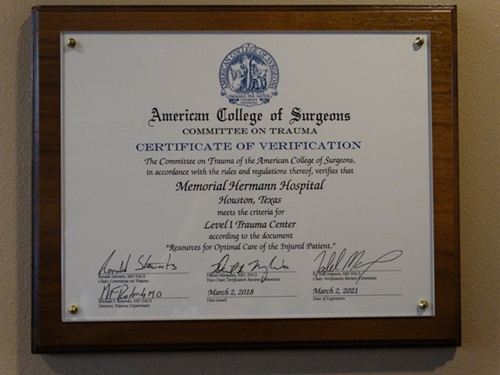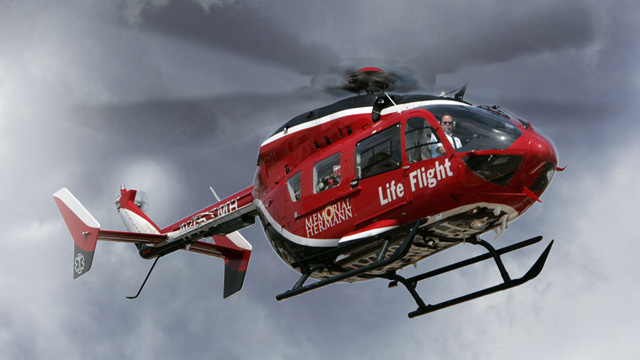It’s one thing to think you’re the best. It’s another to be told that by an objective, credible third party. While Memorial Hermann has a reputation for providing trauma care, the hospital puts itself through the rigors of multiple outside verification and accreditation processes to validate the quality of its programs and care, and to seek ways to continuously improve.
Here, we dissect three of these verifications – for burn care, Level 1 trauma care and medical transport.
Burn Care

Verification review is conducted every three years. Stephanice Stephen, RN, BSN, clinical manager of the John S. Dunn Burn Center at Memorial Hermann-Texas Medical Center, describes the process. “The verification review committee looks at our performance in the areas of quality of patient care, performance improvement (PI), education and outreach, research, advocacy and prevention. Six months ago, we completed our third survey. Each time we were successful, meeting all the criteria, with no deficiencies.”
The process begins when the Burn Center submits a formal request to be verified and receives a questionnaire with over 200 questions about the hospital, staff qualifications, number of patients admitted, number of mortalities and number of transfers. Upon the Burn Center’s completion of the questionnaire, a date is set for a site visit. Two site surveyors review the Burn Center’s questionnaire and formulate questions prior to their visit.
On the first day of the site visit, the Burn Center hosts a dinner for the surveyors, which includes about 20 representatives of the hospital, including Stephen, burn specialists, the Center’s heads of education, case management, rehabilitation, physical therapy and nursing, and the head of the hospital. “They [verification committee] want to know that we have a truly multidisciplinary program and that we have the full support of the hospital, from the very top,” says Stephen.
The next day, the survey team performs a site review, meeting with additional Burn Center team members, such as representatives from central supply and the lab, and supporting physicians from trauma, anesthesiology and the OR. “They’re looking for the cohesiveness of our patient care,” she says.
In an exit interview later that day, the survey team points out strengths and weaknesses of the program. “We don’t want any deficiencies,” says Stephen, “but there’s always room for improvement.” Over the next thirty days, the surveyors make a recommendation to the Verification Review Board and, if the Burn Center is successful, the Board issues the verification.
Stephen says the process is arduous but worth it. “It validates what we do every day, validates our commitment to the community. And it helps us provide the optimal level of care to our patients.”
Level I Trauma

Memorial Hermann’s participation in the survey is spearheaded by Sheila Lopez, RN, BSN, MA, Director of Trauma Services for Memorial Hermann – Texas Medical Center and Children’s Memorial Hermann Hospital, and is Director of Quality and Regulatory for the Memorial Hermann Trauma service line.
“I see my role – in this effort and in my day-to-day job – as a conductor,” says Lopez, who has been with the Trauma service line since 2007 and with the Memorial Hermann Health System for 25 years. “We have a great facility and a great trauma team, starting with EMS. We are very blessed.”
Like the burn survey process, the Level I trauma process begins with an in-depth written application containing questions pertaining to the entire hospital - EMS, emergency, radiology, respiratory, PACU (post-anesthesia care unit), ICU (intensive care unit) – any department the patient touches. This is followed by a site visit from an ACS survey team comprised of two surgeons, an ER physician, a pediatrician and a nurse.
On the first day, the survey team tours the hospital, conducts an in-depth review of about 50 patient charts and reviews the hospital’s Performance Improvement Program, looking for quality of care issues. Later - there is a working dinner during which the survey team reviews the application - to confirm its contents - and conducts a Q&A with the representatives from across the Memorial Hermann trauma spectrum - as well as hospital administration, to make sure everyone fully supports the trauma endeavor.
On the second day, there’s a hospital walk-through that starts with ground EMS and Life Flight® and follows the flow of patient care through the ER, radiology, OR, ICU and the patient floor. The team looks at the qualifications of the physicians, nurses and other care providers; they look at the hospital’s injury prevention and outreach programs; and they look at research.
Once the site visit is complete, the ACS team huddles and writes their report and presents it to the ACS Committee on Trauma (COT), who reviews and ultimately ratifies it. The results, along with observed strengths and weaknesses, are communicated to the Trauma Center. The Memorial Hermann Trauma Center was last verified in November of 2017, with no deficiencies, and has a long history of stellar results.
Medical Transport
An area in which Memorial Hermann stands head and shoulders above the rest is critical care medical transport. The only hospital-based air ambulance serving Houston and surrounding communities, Memorial Hermann Life Flight performs about 3,400 missions a year, making the John S. Dunn Helistop one of the business helipads in the world.
Life Flight is accredited by the Commission on Accreditation of Medical Transport Systems (CAMTS). Life Flight Chief Pilot Damon Sanger and Life Flight Chief Flight Nurse and Education Manager Rodolfo “Rudy” Cabrera, RN, MSN, co-coordinate Life Flight’s participation, as the accreditation encompasses both transport safety and patient care.
CAMTS Accreditation Standards address issues of management and staffing, quality management, patient care and communications and include standards for rotorwing, fixed wing, surface operations, special operations and medical escort services. Life Flight participates in the rotorwing and fixed wing surveys. Accreditation occurs every three years. As with the burn and Level I trauma certifications, CAMTS accreditation includes a written survey and site visit. Life Flight earned its most recent accreditation in April 2018.
From the aviation side, Sanger describes the survey as “an independent look by people in the industry – people who know the job.” He says it’s a different survey each time, which “keeps you sharp and makes you better.” He says while the accreditation cycle is every three years, Life Flight is always preparing. “Our overriding goal is to provide safe and efficient patient transportation. And to that end, we are continuously reviewing and evaluating our performance,” he says.
Sanger attributes Life Flight’s success, in large part, to its very robust training program. “We’re a very complex program with advanced capabilities, which requires a longer training program. Our pilots, on average, spend five to six weeks training. They train until they are completely ready for the job.”
From the patient care standpoint, Cabrera says, “They look at our staff qualifications and our specialty-care protocols - for transporting pregnant and heart attack patients, for instance. They look for skills in areas in which we might have a high incidence of failure due to a low frequency of use, given we’re not operating in a normal hospital setting. They look at equipment. Are our uniforms fire retardant? And communications. Are we hosting regular shift briefing and staff meetings?”
Cabrera, who has been with Life Flight through four surveys, says this one was the best. “Earning your CAMTS certification means you have been evaluated and found to uphold the highest standards of patient safety and care. This one was the best yet. We were extremely prepared.”
Sanger agrees. “It was a very successful visit for us. They gave us high praise for our program, on both the medical and aviation sides.”
Red Duke Trauma Institute Newsletter Sign Up
Use the form below to sign up to receive our Red Duke Trauma Institute Newsletter with helpful articles about our services, case studies relevant to clinical protocols practiced on a daily basis, information about available educational opportunities and many other updates for health care professionals and first responders.
